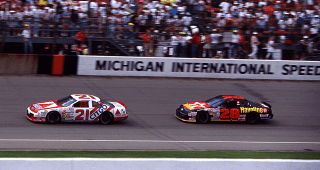Throughout the 2024 NASCAR season, Ken Martin, director of historical content for the sanctioning body, will offer his suggestions on which historical races fans should watch from the NASCAR Classics library in preparation for each upcoming race weekend.
Martin has worked exclusively for NASCAR since 2008 but has been involved with the sport since 1982, overseeing various projects. He has worked in the broadcast booth for hundreds of races, assisting the broadcast team with different tasks. This includes calculating the “points as they run” for the historic 1992 finale, the Hooters 500 at Atlanta Motor Speedway.
The following suggestions are Ken‘s picks to watch before this Sunday‘s FireKeepers Casino 400 at Michigan International Speedway.
It seemed like nothing could go wrong for Cale Yarborough and his No. 11 Junior Johnson-owned team.
They won the NASCAR Cup Series championship in 1976 and 1977. After the first 14 races of the 1978 season, Yarborough led the series standings by 37 points over Benny Parsons.
The halfway point of the season was a stop in Michigan, a track where Yarborough had plenty of success. He won the inaugural race at the track in 1969 and won additional races there in 1970 and 1977.
He was nearly a lock for a top-10 finish at the track. Over his first 14 races at the track, he compiled 11 finishes of 10th or better, with nine of them being in the top five.
Yarborough qualified third for the race, behind David Pearson and Parsons.
It seemed like Yarborough‘s luck at Michigan was about to run out, as he had to duck into the pits for tires. This put him a lap down and it looked like that would be his chance at another victory until the caution flag came out just after the halfway point for an incident between Blackie Wangerin and Al Hobert.
This reset the field and gave Yarborough a second chance. If he wanted to be the first to the checkered flag, he would have to power past a group of strong cars. The strongest of the day seemed to be the DiGard Racing Chevrolet of Darrell Waltrip.
Waltrip, driving the No. 88 car, led 88 of the first 129 laps before his engine let go, sending him to a 28th-place finish.
Yarborough found his way back to the front of the field, checking out on Pearson, Parsons and the rest of the field, en route to a 13-second victory.
His comeback win extended his points lead to 47 points over Parsons, in a season that saw Yarborough eventually capture a record third straight series championship.
“Daddy, start your engine!”
The Petty family couldn‘t have dreamed up a better Father‘s Day in 1986, as Richard Petty was on the brink of history.
Petty was set to make his record-setting 1,000th NASCAR Cup Series start and Michigan International Speedway and NASCAR pulled out all the stops to ensure it was a pre-race memory that would last forever.
“King Richard‘s” three daughters gave the command for their Dad and their Dad only to start his engine, roughly 20 seconds before the rest of the field followed suit. The crowd roared as the No. 43 car came to life for the 1,000th time.
Ken Squier also interviewed Petty while making the preliminary pace laps before the race. He qualified 15th for the race, a few rows ahead of his son, Kyle.
Tim Richmond set the fastest lap during qualifying, but the driver to watch was Dawsonville, Georgia‘s Bill Elliott, who started eighth.
Elliott was in the middle of a torrid stretch at the track. The second race at Michigan saw him start second and finish third. Elliott‘s two races there in 1984 included two pole positions, one victory and a third-place finish. 1985 was more of the same for Elliott, as he won both races from the top spot.
The only surprise was that Elliott had yet to win a race in 1986 after winning 11 of the 28 races in 1985.
Richmond‘s teammate Geoff Bodine and an injured Harry Gant dominated the race, leading 111 of its 200 laps, but it was Elliott whose car came on strongest at the end.
Elliott took his car to the point for the first time on the 150th lap, leading 22 laps before giving up the lead to Gant.
He went on to lead the final five laps on his way to his first victory of the season and his third-straight victory there.
Elliott returned to the track in August and put his No. 9 car in Victory Lane yet again, giving him four straight victories and five of the last six. His final victory at the track came in 1989, giving him seven victories over the 11 races held at the track between 1984 and 1989.
Jarrett and Allison.
Two names synonymous with NASCAR history and visiting victory lane.
Ned Jarrett won 50 races in just 352 starts between 1953 and 1966, capturing the championship in both 1961 and 1965.
Bobby Allison‘s career abruptly came to a halt midway through the 1988 season after a crash at Pocono, just a handful of races after winning the Daytona 500. He won 84 races between 1961 and 1988, won the title in 1983 and finished second in the final season standings five times.
His brother Donnie also made the final start of his career in 1988, winning 10 races in 242 starts.
It was no surprise that these two legacies produced a new generation of talent that could be found at the front of the field every Sunday afternoon.
Bobby‘s son Davey finished second to him in the 1988 Daytona 500 and was quickly carving up a name for himself. He had won two races in 1987, 1988, 1989 and 1990, managing to turn up the heat even hotter in 1991.
He captured victories at Charlotte, Sonoma and Michigan, as he arrived at Michigan for the second time sitting fourth in the season standings.
Dale Jarrett, the son of Ned, didn‘t have as smooth of an entry into the NASCAR Cup Series. He raced for a handful of owners between 1984 and 1989, while still winning races in the Xfinity Series. Jarrett was named the driver of the No. 21 car for the Wood Brothers Racing team in 1990 after their usual driver Neil Bonnett was injured in a crash.
Jarrett drove the final 24 races of the 1990 season for the team, finishing fourth at Atlanta.
The 1991 season saw more success and growth for the Hickory, North Carolina driver. He arrived at Michigan in 15th in the season standings, thanks to a career-best stretch of three straight top-10 finishes.
Allison looked poised to visit Victory Lane at the track for the season sweep, but that was until Jarrett entered the picture.
The two drivers had an incredible back-and-forth battle for the victory over the final laps of the race, as the two took the white flag side-by-side.
The two drivers continued in tow with each other as Bob Jenkins, Benny Parsons, and Jarrett‘s Dad Ned called the final moments of the race.
Jarrett and Allison stayed equal with each other and touched out of the fourth turn, as Jarrett beat Allison to the line by inches in quite possibly the most popular victory in some time.
Ned‘s reaction in the television booth as a proud Father induced goosebumps, as he raved about how clean his son raced for his first victory.
It was also the first victory for the No. 21 team since Kyle Petty won at Charlotte in 1987.
Allison visited Victory Lane to congratulate Jarrett and praised him in his post-race interview with how clean he drove him.
Read the full article here























